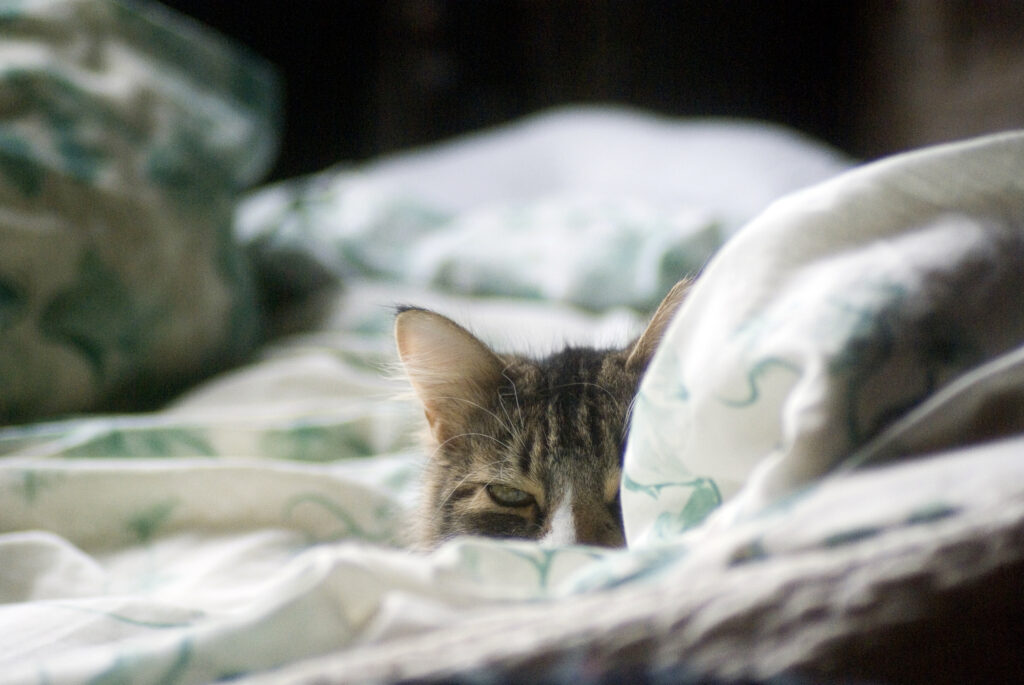Until recently, cats were considered untrainable and even unintelligent because they didn’t respond to common tests and techniques in the way other animals did, notably dogs, to whom they were most often compared. You put them in a maze, which any rodent can complete, but they wander a little bit, then settle down in a corner and even have a bath.
But cats had one up on us—they would respond and could be trained to do most anything, but were waiting for us humans to understand their underlying biology and how that tempered and molded their responses to our requests. The cat in the maze was acting on its own innate intelligence, the one that could save its life if there was a predator or some other threat, or a tasty little mouse to have for breakfast, around that next corner in the maze, and the best way to assess the situation safely was to find a protected spot, sit still, listen, smell, perceive the best way to proceed.
Rather than forcing cats to conform to intelligence tests that work for humans, humans decided to follow the cats to a new understanding of their needs over the past decade and more, so that we could learn to communicate with them on their level and meet their needs as we learned the best ways to study them.
Fear Free
One overall change in handling of all animals, from our domestic companions to livestock to wildlife, has come within the past decade by the name “Fear Free” which acts to enlighten us humans and modify our understanding of animals so that we can eliminate fear, anxiety and stress from their lives.
As animal caretakers we need to recognize that each of the animals we handle in any way is an individual with individual needs as much as we humans are. Animals come to their lives with us from different experiences and react to their situation as a reflection of their lives to that point.
Cats in particular stay very close to their original biology and early socialization in decision-making. Cats are predators, but they are also prey to other animals. Never mind that they live in a house with soft beds and cat trees and food served up to them and humans who adore them—in their experience, in every moment, they recognize that a predator could be poised to strike and kill them, so they keep a constant physical defense against this danger. They maintain a “territory” which is not turf to fight over but the “safe space” they have carefully defined and maintain both through physical premise and body language. Moving out of that territory, or participating in activities that are outside their experience, can cause them to be fearful because they perceive themselves as vulnerable.
Many cats never see a veterinarian, receive poor or no care, are punished or abused, abandoned outdoors or surrendered to shelters, all for behavior that is perfectly natural for their circumstances but which can largely be modified or eliminated by reducing fear and stress. The goal for cats is to provide a space where their fears are recognized and we modify or remove fearful objects or activities so they feel comfortable within it, and also to condition them to places and activities that make them fearful but are necessary for their welfare, like visiting the veterinarian.
Cats and Cooperative Care
“Cooperative Care” goes one step further to actually engage a cat in its own handling and inviting it to be a participant in making decisions. It “involves training an animal to not only tolerate handling and husbandry procedures, but to be an active, willing participant in these experiences.”
Tabitha Kucera RVT, CCBC, KPA-CTP of Chirrups and Chatter utilizes Fear Free techniques and offers a webinar and in-person instruction on Cooperative Care. 6 While giving cats choice may sound far-fetched, break down an activity and you can see there are many points where a cat can indicate preference and comfort that you can respond to. One basic way to give your cat some control is to understand their body language and respond to it: whether you are trimming nails or simply petting your cat and your cat starts to withdraw or react, don’t persist—stop immediately and let the cat relax. If the cat learns that you’re responding to its communication, it will build a bond of trust and thereby reduce fear and stress, and encourage the cat to go along with what you want. It gives them more confidence that they are safe so that they tolerate a situation they may have fought to get out of, and all of this reduces the risk of physical and emotional injury to the cat and the human.
Cooperative care is based on how cats learn, through both classical conditioning, or learning through association, and operant conditioning, or learning through trial and error. Classical conditioning can happen automatically through everyday activities, like the can opener sound association with food—but things can accidentally be conditioned with negative associations, like the dreaded cat carrier associated with a scary trip to the vet. You would use desensitization and counterconditioning to create a positive association with scary things, like treating the carrier like a play space with great food to reinforce the conditioning. Understanding and using pheromone products can enhance a cat’s comfort and also reinforce that the new things they are learning safe.
We did a disservice to cats in an effort to get cats out of shelters and into adoptive homes when we described them as “no care” pets. It’s about time we gave that up.
References:
- “The use of a T-maze to measure cognitive–motor function in cats (Felis catus)”, https://comparativebehavioralresearch.wordpress.ncsu.edu/files/2019/12/ The-use-of-a-T-maze-to-measure-cognitive-motor-function-in-cats-Felis- catus_.pdf
- “Feline Intelligence”, http://www.animalplanet.com/pets/cat-intelligence/
- Fear Free website, https://fearfreepets.com/
- “Your Cat’s Personal Space: Why it Matters”
https://catbehaviorassociates.com/your-cats-personal-space-why-it-
matters/ - “Cooperative Care: The How and the Why” ,
https://winter2019.iaabcjournal.org/cooperative-care/ - Chirrups and Chatter website, handouts,
https://www.chirrupsandchatter.com/



